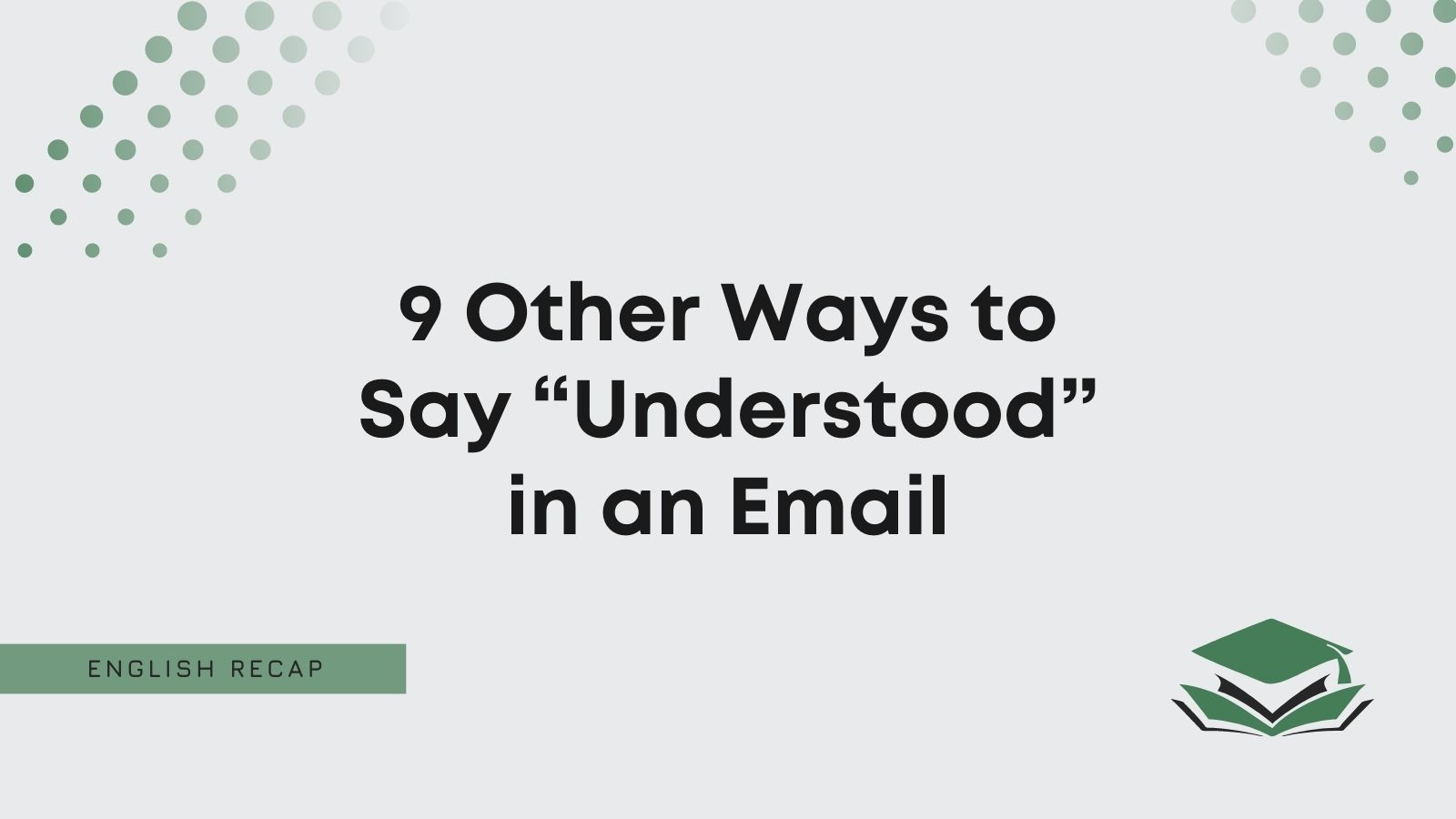You will almost always receive important information in formal emails. It’s vital that you know how to respond to let the sender know you have “understood” the contents of the email.
So, what phrases work instead of “understood”? Well, this article has gathered all the best synonyms to help you.
Is It Professional to Say “Understood”?
It is professional to say “understood,” and it works well in formal emails. It’s only one word, but it works well to quickly let the recipient know that you’ve received and understood the last email they sent to you.
Don’t worry; using one word like this in an email is not rude. With that said, it’s not polite, either. It’s a standard, impersonal word that works when you want to quickly convey understanding or acceptance of a message.
You can use it like so:
Understood. Thank you so much for sharing this information with me.
Pros
- It’s short and sweet.
- It’s very professional.
Cons
- It’s not polite enough to work in more casual settings.
- It’s very impersonal.
In most formal instances, we recommend “understood” because it’s quick, effective, and clear. However, it might help to know a more polite way to understand an email.
So, read on to learn how to write “understood” in an email. There are plenty of options that will help you mix things up.
What to Say Instead of “Understood”
- I understand
- Noted
- That makes sense
- I get what you’re saying
- I’m with you
- Of course
- Sure
- I follow
- Received
1. I Understand
If you want to know how to say “understood” formally, look no further than “I understand.”
Changing the tense is a great way to sound more professional and sincere in your emails.
You should write “I understand” at the start of an email to your boss. It makes it very clear that you understand what they expect from you. That way, your boss won’t need to write a follow-up email to confirm all the details.
You should also refer to this email example:
Dear Mr. Hayward,
I understand what you’ve said. I’ll discuss matters with my team to see what they’d like to do next.
All the best,
Joanna Lum
2. Noted
You can also use “noted” as a one-word alternative to “understood.” It works very similarly, making it a good option if you’re looking to keep things short and sweet.
“Noted” shows that you’ve taken note of the information provided in the previous email. It’s a great way to tell your boss you understand them.
Also, “noted” is a professional term. That’s why it works quite well in most business emails. You should try using it the next time someone shares information via email. If it’s worth noting down, just reply with a simple “noted.”
Here’s a great email sample to help you as well:
Dear Ms. Barker,
Noted. Thank you for sharing this information with me. I’m sure I’ll be able to figure out the next steps alone.
Yours,
Peter Redford
3. That Makes Sense
Depending on who sent you the information, you can also be slightly more conversational. For instance, “that makes sense” is a great friendly synonym that works well when emailing people you work with.
Generally, it’s best to use it when emailing colleagues. We recommend it if you have a good working relationship with them.
“That makes sense” shows you fully understand what they said in their previous email. It shows that you require no further clarification.
Also, the following example should clear things up:
Hi Margaret,
That makes sense. I’ll certainly talk to the people on my team and let you know what they think about the situation.
Kind regards,
Missy Eloise
4. I Get What You’re Saying
You can say “I get what you’re saying” instead of “understood” in most conversational instances.
It shows that you understand someone’s point and want to show that you’re on the same page as them.
This phrase works best for emailing colleagues. It’s a great way to let them know you approve or agree with the things shared via email. You can’t go wrong with using something like this.
We recommend this sample email if you still need more help:
Dear Kyle,
I get what you’re saying, so I’ll continue to work on the project. Let me know if you’d like to help out with any of it.
Yours,
Billy Tomlinson
5. I’m With You
Understanding someone also happens to be quite supportive. That’s why phrases like “I’m with you” go a long way in casual settings.
You might want to use it to show your friends you understand their message.
“I’m with you” shows that you understand what someone is trying to say. It’s better than writing “understood” when you want to sound more friendly and welcoming. Most people will be grateful that you took the time to use a more polite phrase like this one.
Here’s a great email sample if you’re still unsure:
Hi Sue,
I’m with you on this. There has to be a change, and I’ll ask around the office to see who else agrees.
All the best,
Sarah Dunkirk
6. Of Course
“Of course” is a very useful phrase in more conversational situations. It replaces “understood” well, showing that you fully understand what someone is trying to say.
Typically, “of course” means that you require no further explanation. That’s why it’s synonymous with “understood.” It shows you understand every point made in an email or message and don’t need further clarification.
This email sample will also help you understand more about it:
Dear Penny,
Of course, I’ll be happy to oblige. Thank you so much for sharing the information with me. I look forward to working with you.
Best wishes,
Emily Heritage
7. Sure
One-word options are always clear and direct. After all, if you can convey enough information to explain yourself in one word, why bother using any more?
However, “sure” works slightly differently than “understood.” Where “understood” is very professional and polite, “sure” is much more conversational and friendly.
It’s still useful, but you should reserve it for emailing coworkers. It’s much better when you have a good working relationship with the email recipient. It shows that you understand the previous email and want to move on to the next most important thing.
Here’s a great email example to show you how it works:
Hi Richard,
Sure. You do not have to tell me any more about the situation. I’ll happily help you however I can.
All the best,
Britney Walker
8. I Follow
If you want to know how to write “understood” in an email, you can also try “I follow.”
It’s very professional and shows that you follow everything your employer shared with you in a previous email.
Being able to “follow” information is a skill. So, you can include it in a reply email after someone has tried to update you on business matters. It shows you understand and respect everything mentioned in the email.
You can also refer to this example:
Dear Whitney,
I follow what you’re saying, of course. Is there anything else you’d like me to do before we move to the next stage?
Best wishes,
Charlotte Tilbury
9. Received
Did you know that “understood” is often part of a larger phrase? The phrase “received and understood” is very common in most formal emails.
Therefore, you can also use the other word in the phrase. “Received” is just as good as “understood” in most professional instances.
You can use it to tell your boss you understand their message. While “received” doesn’t directly express an understanding, it still shows you have read through and accepted the content of their email.
Why not refer to this example if you’re still unsure:
Dear Joe,
Received and understood. Thank you so much for sending all of this to me. I still wasn’t sure if you trusted my input.
Yours,
Rosie Cook

